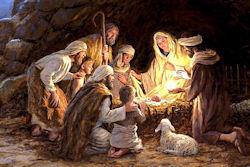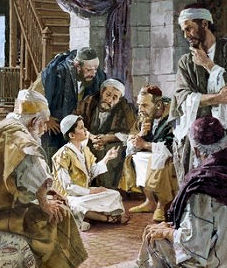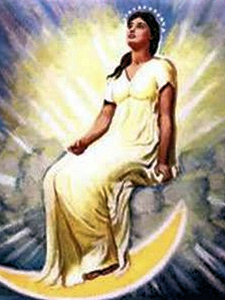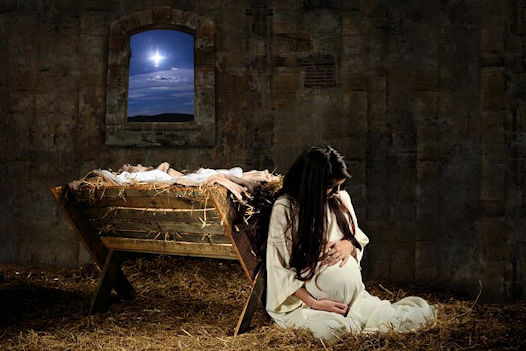The full story of Mary’s marriage, pregnancy, and birth of her son can be found in two books of the Bible: the Gospels of Matthew and Luke. For those who want to read (or reread) the story, the accounts are in Matthew 1:18–2:23 and Luke 2:1–40.
This scripture is the wonderful Christmas story, concerning Mary’s virgin birth of Jesus on December 25th, a couple thousand, or so, years ago. To be honest, there are a lot of so-called “facts” to this story, told in church sermons and holiday plays and Christmas songs, that are not really all that factual. And there are some real facts that need a bit of explanation, as well as some just plain, old incorrect assumptions. So, just for fun, let’s see what people think and then compare it to the written story as it appears in the Bible.1
So, when did this birth take place? Actually, the date is not mentioned in the Bible, but most modern scholars believe Jesus was born in late September or early October. There has always been disagreement about his birth date. Clement of Alexandria wrote that some said it took place in the Egyptian month of Pachon (on May 20), others said it was in the month of Pharmuthi2 (on April 20 or 21). Suggested in other writings are April 18 or 19, March 25, January 2, November 17 and November 20. So, as you can see, these supposed dates are widely scattered.3
 We hear there was no room at the Inn when Mary was about to give birth, so Jesus was born in a stable and laid in a wooden manger (feed trough4)? “Churches, like the Greek Orthodox Archdiocese of America, state that Jesus was born in a cave, as they were used by shepherds of the time to shelter animals from hostile weather.”5 And there are historical records to suggest that, during the first-century, animals were kept in caves and that feed troughs were generally made of stone, not wood.6
We hear there was no room at the Inn when Mary was about to give birth, so Jesus was born in a stable and laid in a wooden manger (feed trough4)? “Churches, like the Greek Orthodox Archdiocese of America, state that Jesus was born in a cave, as they were used by shepherds of the time to shelter animals from hostile weather.”5 And there are historical records to suggest that, during the first-century, animals were kept in caves and that feed troughs were generally made of stone, not wood.6
A very fascinating theory is that Jesus was born in a house, not a stable or a cave. A United Kingdom theologian, Ian Paul, says that the ‘birth of Jesus’ story is based upon a misreading of the New Testament. “Dr. Paul argues that the Greek word, kataluma, usually translated as ‘Inn’ was in fact used for a reception room in a private house – the same term is used to describe the ‘upper room’ where Jesus and his disciples ate the last supper. An entirely different word, pandocheion, is used to describe an ‘Inn’ or any other place where strangers are welcomed.”7
Some scholars have speculated that Joseph and Mary may have sought to stay with relatives in Bethlehem, so the author argues that Joseph and Mary would not have been staying at a public Inn. “The only reason for them to travel to Bethlehem for the census was because he [Joseph] had family there and if he did, the customs of first-century Palestine required him to stay with relatives and not with strangers. In that context, the kataluma where he stayed would not have been an Inn, but a guest room [or upper room] in the house of the family where Joseph and Mary were staying.” That room could very well have been full with other relatives who had arrived before them, so they needed to settle down in a different area of the house.8
 “The actual design of Palestinian homes (even to the present day) makes sense of the whole story.” Paul continues, “Most families would live in a single-room house, with a lower compartment for animals to be brought in at night . . .” That would mean Jesus was not born in a barn, but within the area where the animals were kept inside the house.9
“The actual design of Palestinian homes (even to the present day) makes sense of the whole story.” Paul continues, “Most families would live in a single-room house, with a lower compartment for animals to be brought in at night . . .” That would mean Jesus was not born in a barn, but within the area where the animals were kept inside the house.9
How many wise men visited Jesus when he was born? Well, the short answer is none! No such wise men (or Kings or Magi) did so at his birth. It was much later when they arrived and the Bible completely omits how many of them made the trip, so we really don’t know if it was two, three, or maybe more.
Also, the Bible does not specify the interval between the birth and the visit. It took much time to prepare for such a trip and then travel a long distance, so by the time the visiting men located where Jesus was living, it is figured that he must have been between six months and two years of age. They gave him three gifts: gold, frankincense, and myrrh. Because there were three different gifts, it is only speculated that each came from a different wise man. We really don’t know how many they were, only that it was at least two.10
The Mention of Mary in the New Testament
In original manuscripts, the name Mary is based upon the Aramaic name (מרים), which is transliterated Maryam or Mariam. The English, Mary, comes from the Greek Mapia. This name is mentioned twelve times in Luke, six times in Matthew, and once in Mark. Mary is mentioned, not by name, but by reference as Jesus’ mother twice in Mark and twice in John. In Acts, she along with Jesus’ brothers, are mentioned as attending a gathering at an upper room after Jesus departed for heaven.11
Most written accounts of her are before, and immediately after, the birth of her son. There is only one mention of Mary (or her son) during Jesus’ whole adolescent life. “At the age of twelve, Jesus, having become separated from his parents on their return journey from the Passover celebration in Jerusalem, was later found in the Temple among the religious teachers.”12 (See Luke 2:41-52.) A few times, there is a mention of her after Jesus begins his ministry, up until shortly after his death.
About the Virgin Birth — and Mary’s Husband
A previous scientific study on the subject of Jesus’ virgin birth is listed in References & Notes at the end of this article.13 That article, titled “Jesus’ Mother was a Virgin — What? Is That Even Possible?” was to be part of this discourse, but the scientific explanations needed made its length too much for this narrative. But, in one paragraph of that article, I wrote the following.
Now, I do not hold to the perpetual virginity belief of Orthodox and Roman Catholic churches, as well as some Protestant leaders (e.g., Martin Luther, John Wesley, John Calvin).14 The Bible states that Jesus’ mother did have other male children — James, Joseph, Judas, and Simon, as well as unnamed girls. “Is not this the carpenter’s son? Is not his mother called Mary? And are not his brothers James and Joseph and Simon and Judas? And are not all his sisters with us?” (Matthew 13:55-56, NRSV).
 But for this more generalized treatise on Mary, I should add more opinions for your consideration, concerning her perpetual virginity and the role of Joseph, Mary’s husband.
But for this more generalized treatise on Mary, I should add more opinions for your consideration, concerning her perpetual virginity and the role of Joseph, Mary’s husband.
We need to understand Hebrew marriage customs at the time. “Marriages were arranged for individuals by parents, and contracts were negotiated. After this was accomplished, the individuals were considered married and were called husband and wife. They did not, however, begin to live together. Instead, the woman continued to live with her parents and the man with his [family] for one year.”15
This waiting period was to demonstrate truth of the Bride’s purity. “If she was found to be with child in this period, she obviously was not pure, but had been involved in an unfaithful sexual relationship. Therefore the marriage could be annulled. If, however, the one-year waiting period demonstrated the purity of the bride, the husband would then go to the house of the bride’s parents and in a grand processional march lead his bride back to his home. There they would begin to live together as husband and wife and consummate their marriage physically.”16
Joseph and Mary were within that one-year waiting period, when she became pregnant. Being betrothed (or espoused) was a permanent relationship equivalent to marriage,17 so the “union could be dissolved only by regular divorce [or annulment]. Breach of faithfulness was regarded as adultery, and was punishable with death (Deuteronomy 22:23-24).”18 But never before, in all of history, had there ever been a virgin birth, so when people saw such a situation as Mary’s, there could only be one possible explanation.19
Since he really loved Mary, Joseph decided to have a quiet divorce, so as not to cause a public scandal. But then he received a vision from an angel in a dream (Matthew 1:20), which explained everything, so he changed his mind. This situation demonstrates the exemplary character of Joseph, because he “did not question the angel’s explanation for Mary’s pregnancy”20 and continued his plans to take Mary as his wife.
The Last Mention of Joseph
 After the time Jesus became separated from his parents in Jerusalem (Luke 2:41-51), that was the last we hear of Joseph. It is supposed, by many, that he died before the beginning of Jesus’ public life. “The Gospels speak of the latter’s mother and brothers (Matthew 12:46; Mark 3:31; Luke 8:19; John 7:3), but never do they speak of his father in connection with the rest of the family.” In the apocryphal text, ‘Story of Joseph the Carpenter’, he died in the year A.D. 18 or 19, when Jesus may still have been a teenager.
After the time Jesus became separated from his parents in Jerusalem (Luke 2:41-51), that was the last we hear of Joseph. It is supposed, by many, that he died before the beginning of Jesus’ public life. “The Gospels speak of the latter’s mother and brothers (Matthew 12:46; Mark 3:31; Luke 8:19; John 7:3), but never do they speak of his father in connection with the rest of the family.” In the apocryphal text, ‘Story of Joseph the Carpenter’, he died in the year A.D. 18 or 19, when Jesus may still have been a teenager.
Other reasons it is thought that Joseph died previously, were the facts that only Mary was present at the wedding in Cana, and there was no mention that he was at the crucifixion of Jesus, either.21 Furthermore, would Jesus, “when about to die on the Cross, have entrusted his mother to John’s care, had St. Joseph been still alive?”22
And, according to the apocryphal ‘Gospel of James’, Joseph was previously married and, before his wife died, they had six children (four boys and two girls), and one of them, whose name was James, was known as “the Lord’s brother.”23 Many researchers feel all this fits and makes a lot of sense and could be true. But, it doesn’t matter whether Mary had more children or not, if she had intercourse with her husband, she was surely not a perpetual virgin. And she did have intercourse with him after Jesus’ birth, as mentioned in Matthew, “. . . he took her as his wife, but had no marital relations with her until she had borne a son,” (Matthew 1:24b-25a, NRSV).
When you research the details from many sources, it appears that Mary’s family was looking for a marriage that would produce a royal and priestly lineage. Joseph came from the line of David; Mary came from the family of Aaron. Well, that proposed marriage could certainly produce what they wanted, and even better — the real result was, legally, Jesus had a royal and priestly lineage, but an actual Godly lineage, too.
But, about any other offspring delivered by Mary, many believe she had other children. Some people look at the description of Jesus as being Mary’s first-born and conclude there were others, or at least one more. “And she gave birth to her firstborn son,” (Luke 2:7a, ESV).
Mary in Other Scripture & Texts
 Some people believe Mary is mentioned in the book of Revelation. There is a reference there of a “woman clothed with the sun” (see: Revelation 12:1-6). One author who makes that connection is Jean-Pierre Ruiz in an article in New Theology Review.24 But an East Orthodoxy layman disagrees and offers a critical interpretation of the text, writing that Revelation 12:2 “is clearly not about the Virgin Mary, but about the Church.”25 Besides the Virgin Mary or the Christian Church, I’ve heard other ideas of whom Revelation 12:1–6 is supposed to represent, including Old Testament Israel and the Roman government.
Some people believe Mary is mentioned in the book of Revelation. There is a reference there of a “woman clothed with the sun” (see: Revelation 12:1-6). One author who makes that connection is Jean-Pierre Ruiz in an article in New Theology Review.24 But an East Orthodoxy layman disagrees and offers a critical interpretation of the text, writing that Revelation 12:2 “is clearly not about the Virgin Mary, but about the Church.”25 Besides the Virgin Mary or the Christian Church, I’ve heard other ideas of whom Revelation 12:1–6 is supposed to represent, including Old Testament Israel and the Roman government.
The Jews, of course, have no interest in the Virgin Mary of the New Testament, for they are still waiting for the Messiah and believe this whole Christian ‘son of God’ idea a fantasy. The one man among their people, who claimed to be the Messiah, they rejected and killed by crucifixion. But in Catholic literature, including that of the doctrine of Perpetual Virginity, Mary is mentioned more than she is in the New Testament. And the Islamic perspective on the Virgin Mary and her family is recorded in lengthy detail in the Quran, although not as much so as in Catholic texts of faith.26
Islam’s holy book devotes two chapters (seventy verses) to Mary and her family, in which she is referred to as “Sayyidana Maryam (Our Lady Mary) and Batul (the Virgin).” She is actually the only woman named in the Quran. In there is a strange statement that “God sent his Spirit to Mary in the form of a perfect man bringing tidings of a ‘pure boy’,” or a ‘learned boy’ in some translations. And through the Angel Gabriel, God ‘cast’ his Spirit into her.27 But, odd is the fact that Jesus is only described as the “son of Mary” and not the son of God. Neither these teachings of the Islamic faith, nor those of the Catholic Church, are in the Christian Bible.28
Conclusion
The song selection for this article about the mother of Jesus is ‘Mary, Did You Know’. You have probably heard of this extremely popular song, as it has been performed by, literally, hundreds of artists over the years since it was written in 1984. It has now become a modern Christmas classic.
The rhetorical question, suggested in the title, reflects upon what Mary must have thought about as Jesus completed his ministry. My selection is sung by the writer of this song, Mark Lowry. Selected lyrics are below and the music video (closed captions available) can be viewed by using the link in References & Notes.29
 Mary, did you know
Mary, did you know
that your Baby Boy would one day walk on water?
Mary, did you know
that your Baby Boy would save our sons and daughters?
Did you know
that your Baby Boy has come to make you new?
This Child that you delivered will soon deliver you.
![]()
Copyright © 2020, Dr. Ray Hermann
OutlawBibleStudent.org
→ Leave comments at the end, after ‘References & Notes’.
You can see our basic rules for comments by clicking “The Fine Print” on the top menu bar.
Reference & Notes
- These fun facts are taken from an article I wrote a couple of years ago, titled “A few questions about Christmas – and what is it with all that glitter?” https://outlawbiblestudent.org/a-few-questions-about-christmas-and-what-is-it-with-all-that-glitter/
- Pharmuthi: also known as Par mouti and Barmudah, is the eighth month of the ancient Egyptian and Coptic calendars. It lasts between April 9 and May 8 of the Gregorian calendar.
“Parmouti”, (Wikipedia, Wikipedia Foundation Inc., 24 August 2020), https://en.wikipedia.org/wiki/Parmouti - “Christmas,” (Wikipedia, Wikimedia Foundation, Inc., 28 October 2018), https://en.wikipedia.org/wiki/Christmas
- manger: a trough or open box in a stable designed to hold feed or fodder for livestock.
Merriam-Webster’s Collegiate Dictionary, 11th ed., (Springfield, MA: Merriam-Wester, Inc., 2003). - Gryboski, Michael, “Christmas History: Was Jesus Born in a Cave?” (The Christian Post, 25 December 2013), https://www.christianpost.com/news/christmas-history-was-jesus-born-in-a-cave-111405/
- Abbott, Shari, “Was Jesus Born in a Stable, a Cave or a House?” (Got Questions, 8 December 2014), https://reasonsforhopejesus.com/was-jesus-born-in-a-stable-cave-house/
- Brown, Andrew, “Jesus was not born in a stable, says theologian,” (The Guardian, 23 December 2014), https://www.theguardian.com/world/2014/dec/23/jesus-christ-not-born-in-stable-theologian-new-testament
- Ibid.
- Ibid.
- Hovind, Eric, “The Wise Men and the Star.” (Creation Today, 28 November 2011), https://creationtoday.org/the-wise-men-and-the-star/
- “Mary, mother of Jesus”, (Wikipedia, Wikipedia Foundation, Inc., 2 October 2020), https://en.wikipedia.org/wiki/Mary%2C_mother_of_Jesus
- Walvoord John F. and Zuck, Roy B., (Eds.), The Bible Knowledge Commentary: An Exposition of the Scriptures, (Wheaton, IL: Victor Books, 1985), vol. 2, p. 210.
- Hermann, Ray, “Jesus’ Mother was a Virgin — What? Is That Even Possible?” (The Outlaw Bible Student, OBS, 2 October 2020), https://outlawbiblestudent.org/jesus-mother-was-a-virgin-what-is-that-even-possible/
- “Brothers of Jesus”, (Wikipedia, Wikipedia Foundation Inc., 16 September 2020), https://en.wikipedia.org/wiki/Brothers_of_Jesus
- Barbieri, Louis A. Jr., The Bible Knowledge Commentary: An Exposition of the Scriptures, 1985, vol. 2, pp. 18-20.
- Ibid.
- Barry, John D., et al., Faithlife Study Bible, (Bellingham, WA: Lexham Press, 2012, 2016), Mt 1:18.
- Vincent, Marvin Richardson, Word Studies in the New Testament, (New York: Charles Scribner’s Sons, 1887), Matthew 1:18.
- MacDonald, William, Believer’s Bible Commentary: Old and New Testaments, Arthur Farstad, (Ed.), (Nashville: Thomas Nelson, 1995), p. 1205.
- Hultberg, Alan, CSB Apologetics Study Bible, (Nashville: Holman Bible Publishers, 2017), p. 1170.
- Easton, M. G., Easton’s Bible Dictionary, (New York: Thomas Nelson, 1893).
- Knight, Kevin (Ed.), “St. Joseph”, (New Advent Catholic Encyclopedia, retrieved 3 October 2020), https://www.newadvent.org/cathen/08504a.htm
- Allison, Dale C., Matthew: A Shorter Commentary, (London; New York: Continuum International Publishing Group [now Bloomsbury Academic], 2004).
- Ruiz, Jean-Pierre. “Between the Crèche and the Cross: Another Look at the Mother of Jesus in the New Testament.” (New Theology Review. August 2010), vol. 23, no. 3, pp. 5-15.
- Truglia, Craig, “Who is the “Woman Clothed With the Sun” in Rev 12?” (Orthodox Christian Theology, 25 August 2019), https://orthodoxchristiantheology.com/2019/08/25/who-is-the-woman-clothed-with-the-sun-in-rev-12/
- McAuliffe, Jane Dammen, (Ed.), “Mary” in Encyclopedia of the Qur’ān, (Boston, MA: Brill Publisher, 2001-2006), vol. 3.
- Jestice, Phyllis G., (Ed.), “Maryam/Mary” in Holy People of the World: a Cross-Cultural Encyclopedia, (Santa Barbara, CA: ABC-CLIO, 2004), vol. 3., p. 355.
- “Mary, Did You Know”, (Wikipedia, Wikipedia Foundation Inc., 14 September 2020), https://en.wikipedia.org/wiki/Mary,_Did_You_Know%3F
- “Mark Lowry – Mary, Did You Know (Live)”, Artist and lyrics: Mark Lowry; music written by Buddy Greene; Featuring ‘The Martins’, and ‘First Baptist Church Choir’ of Hendersonville, TN; Album: Dogs Go To Heaven, (YouTube license UMG/Gaither Music Group, Capitol GMG Publishing, others) – MUSIC VIDEO: https://youtu.be/FF9GwomhKzs

